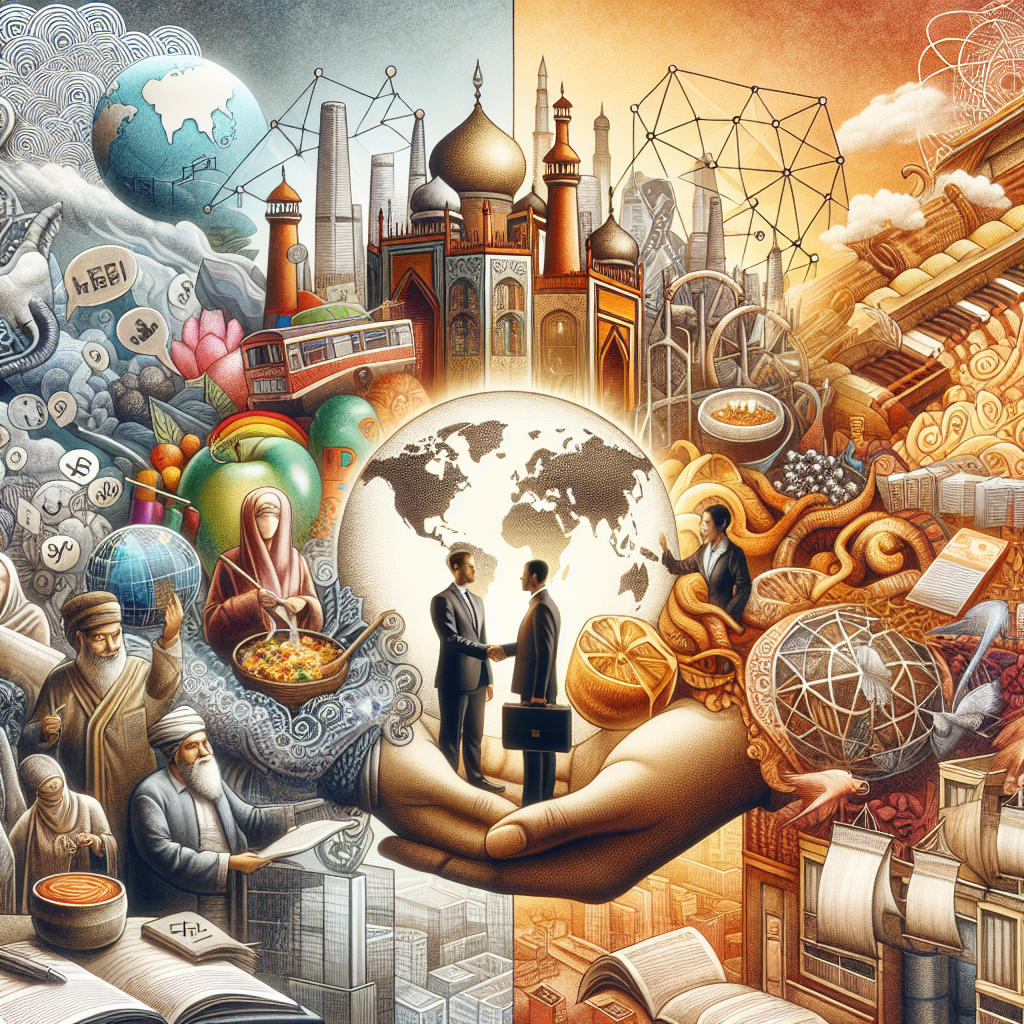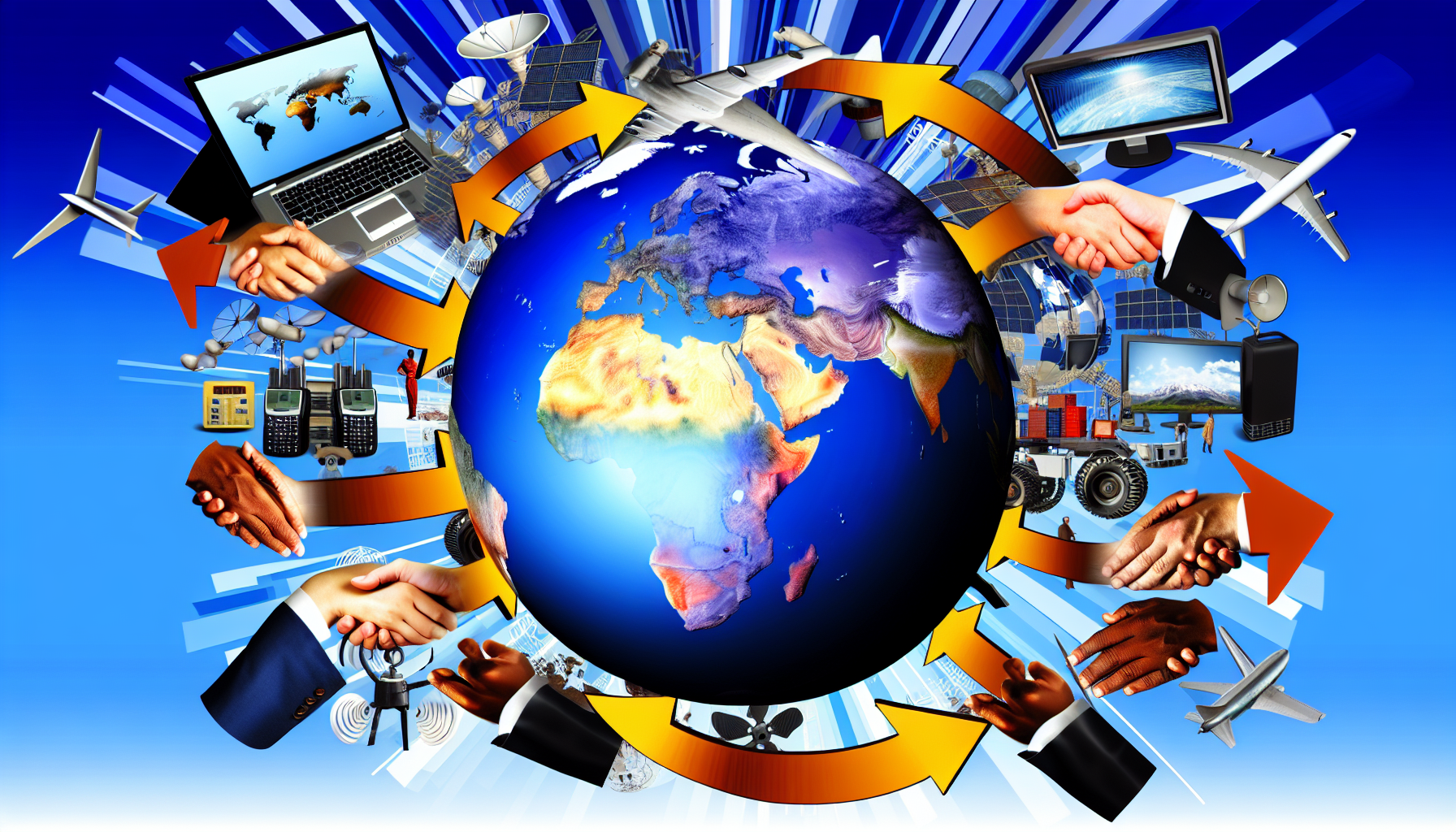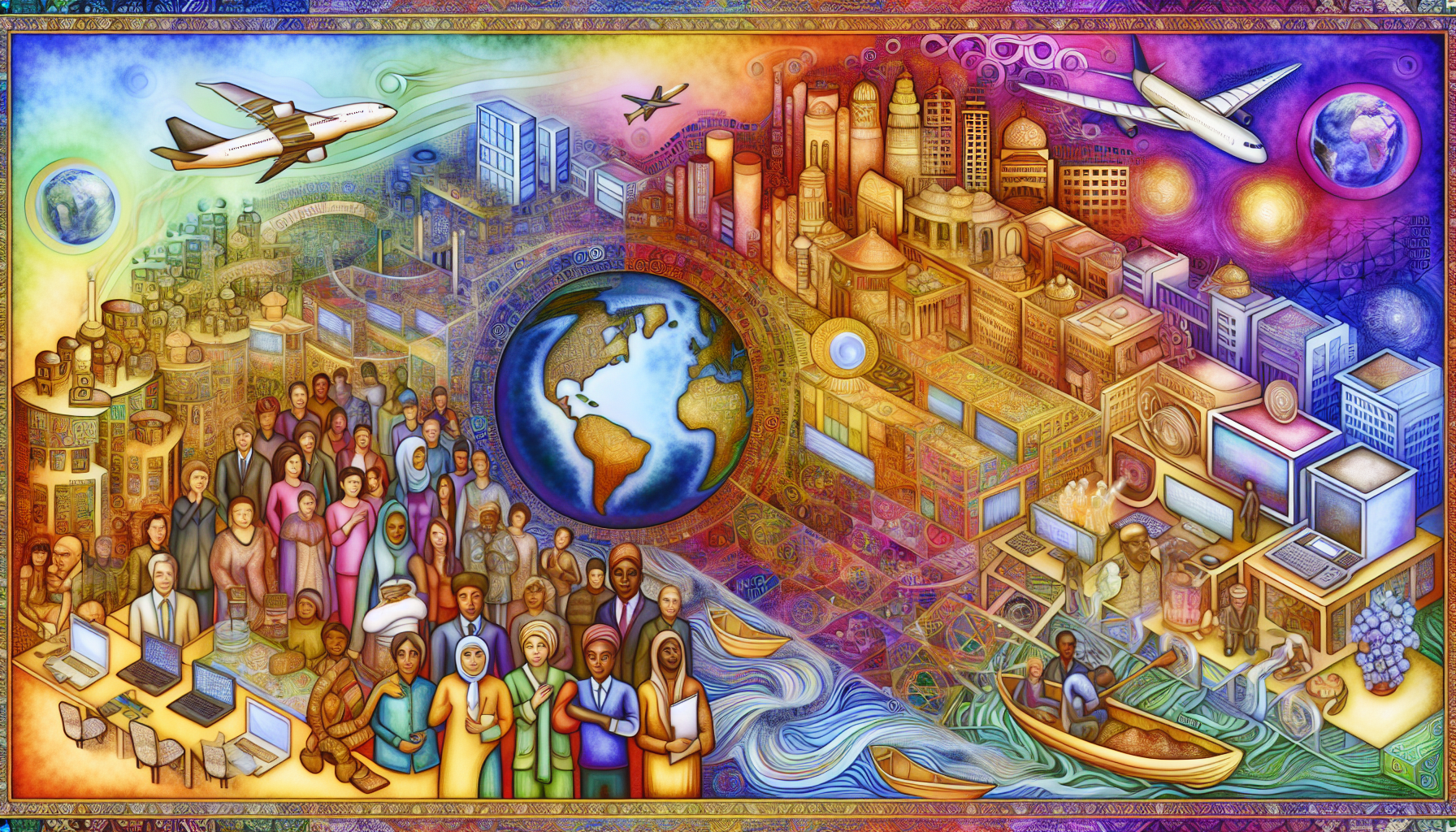Exploring the intricate relationship between globalization, cultural exchange, and economic integration, and how they influence societies and markets worldwide.

Globalization refers to the process by which businesses, cultures, and economies develop in an interconnected manner across national boundaries.
It encompasses a wide range of interactions and exchanges that facilitate the movement of goods, services, ideas, and people around the globe. As a dynamic phenomenon, globalization has evolved significantly over the years, shaped by advancements in technology, shifts in political policies, and changes in societal attitudes. Its multifaceted nature includes cultural, economic, political, and technological dimensions, each contributing to a complex web of relationships that define the modern global landscape.
At its core, globalization can be viewed through the lens of cultural exchange, where diverse ideas, customs, and values intermingle across different societies. This cultural dimension highlights how globalization fosters mutual understanding and appreciation among varied populations, leading to enriched cultural experiences and practices. Concurrently, economic integration is a pivotal aspect, characterized by international trade, investment, and the emergence of global supply chains. Such economic interdependence not only drives growth and innovation but also raises questions about equity and sustainability in a rapidly changing world.
Political dimensions of globalization entail the influence of international institutions and agreements in shaping state relations and governance. These entities often play critical roles in facilitating diplomatic dialogue, promoting economic cooperation, and addressing global challenges, such as climate change and inequality. Meanwhile, technological advancements serve as the backbone of globalization, enabling instant communication and the seamless transfer of information, thereby narrowing geographical distances and facilitating access to global marketplaces.

This comprehensive overview lays the groundwork for a deeper exploration of the profound effects of globalization on cultural exchange and economic integration. Understanding these fundamental components will assist readers in grasping the intricate processes at play in our increasingly interconnected world.
Globalization has significantly transformed the landscape of cultural exchange, acting as a conduit for diverse customs, ideas, and innovations to permeate societies across the globe. This phenomenon has facilitated greater understanding and appreciation of different cultures, enriching social experiences for many. With the ease of international travel and the advent of digital communication, individuals can now access a plethora of global influences that were previously beyond their reach. Such interactions often lead to increased diversity, allowing for the blending of traditions, languages, and lifestyles, thereby fostering creativity and innovation.
As cultures intermingle, the result can be a vibrant mosaic of shared human experiences. For instance, cuisine, fashion, music, and art from various cultures are frequently integrated and celebrated in multicultural societies. This dynamism encourages novel expressions of identity and contributes to a more interconnected world. The cross-fertilization of ideas can inspire unique collaborations, enhancing artistic and intellectual pursuits. However, while the positives of cultural exchange are notable, it is equally crucial to recognize the inherent challenges it poses, particularly regarding local traditions and identities.
One significant downside of globalization-driven cultural exchange is the risk of cultural homogenization. As dominant cultures exert influence on less prominent ones, unique local traditions, languages, and practices may face erosion. In many instances, the commercialization of culture leads to superficial representations, stripping them of their deeper meanings and significance. The loss of local identities can result in communities feeling a disconnection from their roots, ultimately affecting social cohesion and cultural pride. Thus, while globalization can serve as a platform for cultural enrichment, it also raises important questions about the safeguarding of local traditions against the tide of a dominant global culture.
Technology plays a pivotal role in fostering cultural exchange by providing platforms that facilitate communication and interaction among individuals from diverse backgrounds. The advent of digital platforms, particularly social media, has revolutionized the manner in which cultures engage. Individuals can share thoughts, customs, and artistic expressions instantaneously, transcending geographical barriers. This immediate access to global perspectives promotes understanding and appreciation of cultural diversity, driving more profound connections between people. For instance, platforms like Instagram, Facebook, and Twitter serve as modern-day town squares where users partake in cultural dialogues, share experiences, and celebrate diversity.
Furthermore, communication technologies such as video conferencing tools have allowed for unprecedented levels of interaction. Virtual meetings, webinars, and online workshops enable direct communication between cultures that may have previously had limited opportunities for dialogue. Such technology amplifies the participation of voices from marginalized communities, fostering inclusivity in global discussions. This is evident in many educational and professional contexts, where institutions collaborate internationally to share methodologies, practices, and cultural insights. As a result, the blending of diverse viewpoints not only enhances knowledge but also enriches the educational landscape.
Emerging trends such as virtual cultural events and digital art installations are further indicators of how technology is reshaping cultural interactions. Events that utilize virtual reality and augmented reality technologies enable individuals across the globe to participate in cultural festivals, exhibitions, and performances, promoting a sense of shared experience. Additionally, artists leverage digital platforms to create and distribute their work, often drawing inspiration from multiple cultures, thus creating hybrid forms of expression that reflect global interconnectedness. These technological advancements signify a shift toward a more inclusive and interactive approach to cultural exchange, fostering global dialogues that will likely evolve in the future.
Economic integration is a fundamental aspect of globalization that facilitates the interconnectedness of national economies. It involves the merging of various markets and economies to increase trade, investment, and cooperative economic policies among countries. This phenomenon is primarily driven by international trade agreements, which aim to reduce barriers such as tariffs and quotas, thereby enabling smoother and more equitable trade relationships.
Over the past few decades, we have witnessed a significant rise in multinational corporations, which play a pivotal role in promoting economic integration. These corporations operate across multiple countries, establishing global supply chains that take advantage of varied resources, labor, and production capabilities. By doing so, they foster innovation and efficiency, contributing to the economic growth of both developed and developing nations. The establishment of these integrated production networks allows countries to focus on their comparative advantages, ultimately enhancing the global goods and services market.
Global supply chains exemplify the intricate interdependence created by economic integration. Countries no longer operate in isolation, as the production of a single product often involves multiple nations. For instance, a smartphone may be designed in one country, components manufactured in another, and assembled in yet another location before reaching consumers worldwide. This level of integration not only optimizes production costs but also promotes the sharing of technology and expertise, encouraging developmental leaps that benefit participating nations.
Through economic integration, countries are increasingly able to share vital resources and knowledge, enhancing their innovative potential. By fostering collaboration and establishing strong economic ties, economic integration revitalizes growth and stability, paving the way for shared prosperity in an interlinked global economy.

Global economic integration offers a plethora of benefits that significantly enhance international trade and development. Foremost among these advantages is the facilitation of increased economic growth. When countries integrate into the global economy, they often experience heightened productivity and innovation, leading to an overall boost in their economic performance. By removing trade barriers, nations can access a wider range of goods and services, which can stimulate domestic industries and attract foreign investment.
Access to new markets is another critical benefit of global economic integration. This access allows businesses to expand their customer base beyond local borders, fostering competition and driving down prices for consumers. Consequently, as companies scale their operations internationally, they can achieve economies of scale, which further enhances profitability. This growth trajectory is evident in many emerging economies that have embraced globalization, leading to an influx of products and services that enrich local communities.
Job creation is yet another significant outcome of global economic integration. As companies embark on international ventures, they often require a larger workforce, thus providing new employment opportunities for local populations. Regions actively participating in the global marketplace tend to witness a more dynamic labor market, with various skill sets becoming increasingly relevant. The exchange of knowledge and skills also flourishes in this context, as global integration facilitates the transfer of technology and expertise between countries. Essential skills that employees acquire through international collaboration can lead to increased efficiency and higher standards in various industries.
Several case studies highlight the positives of economic integration. For instance, countries like Vietnam and India have successfully navigated the global landscape, reaping the benefits of foreign direct investment and fostering sustainable growth. Their experiences illustrate how proactive integration into the global economy can yield significant social and economic advancements.
The phenomenon of globalization, while fostering economic integration and cultural exchange, also presents several critical challenges and risks. One significant concern is the exacerbation of economic inequality. As countries become more interconnected, there is a tendency for wealth to accumulate in certain regions or among specific social classes, often leaving behind vulnerable populations. This growing disparity can result in social and economic tensions, undermining the potential benefits of globalization.
Job displacement is another critical issue stemming from economic integration. As firms expand their operations internationally, local labor markets may suffer. Industries that cannot compete with cheaper imports or global labor costs may increasingly downsize or close, leading to unemployment and a sense of insecurity among the workforce. This trend can provoke public outcry and resistance against globalization, as communities struggle to adapt to rapid economic changes while facing uncertain employment prospects.
Furthermore, the vulnerability of local industries poses a significant risk. Small and medium enterprises (SMEs) often lack the resources necessary to compete with multinational corporations. The influx of foreign goods can undermine local production, threatening the sustainability of regional economies. As local businesses struggle to maintain their market presence, communities may experience cultural homogenization, diminishing the rich variety of local traditions and practices.
The political implications of globalization cannot be overlooked either. The increased interdependence of nations can lead to difficulties in maintaining national sovereignty, as domestic policies may be influenced by international agreements and market forces. This dynamic can spur social unrest, particularly in regions where citizens feel their voices are marginalized in favor of global interests. Thus, while global integration presents substantial opportunities, the associated challenges necessitate careful consideration and proactive strategies to mitigate risks.
Globalization has fostered an environment where countries can engage in cultural exchange and economic integration, leading to unique developmental outcomes. One exemplary case is the cultural collaboration between Japan and the United States. The post-World War II period in Japan saw an influx of American culture, particularly through music, film, and fashion, which resonated with the younger Japanese generation. This cultural exchange not only enriched Japan’s artistic landscape but also opened new markets for American products, facilitating economic integration and growth through exports and shared experiences.
Another notable example is the EU’s Erasmus Programme, which has significantly boosted educational and cultural exchanges among European countries. Since its inception in 1987, millions of students have benefited from studying abroad in partner countries. This educational initiative has not only enhanced cultural understanding but also laid the groundwork for a more integrated European labor market. The exposure to diverse cultures fosters cooperation and builds a sense of European identity, which in turn promotes economic ties across the continent.
Additionally, the cultural exchange between Brazil and Africa provides a rich narrative of shared history and cooperation. Brazil’s cultural landscape is heavily influenced by African traditions, particularly in music, dance, and cuisine. In recent years, Brazil and several African nations have sought to enhance economic ties through initiatives such as trade agreements and cultural festivals. These collaborative efforts have not only rekindled deep-rooted cultural connections but have also spurred tourism and investment, showcasing the potential economic benefits of cultural ties.
These case studies illustrate the multifaceted nature of cultural exchange and economic integration brought forth by globalization. By understanding the strategies that complement these exchanges—such as promoting educational programs and facilitating trade—countries can glean actionable insights to enhance their own experiences in the global arena.
In a rapidly globalizing world, individuals and businesses must adapt to new norms and practices to thrive effectively. One significant strategy is to embrace cultural awareness. Understanding and respecting diverse cultural perspectives can enhance communication and foster stronger relationships in a multicultural environment. This cultural competency is vital for businesses looking to expand internationally, as it can lead to better collaboration with local partners and an improved understanding of consumer behavior.
Another effective approach is to utilize technology for business expansion. The digital landscape offers countless tools and platforms that facilitate the entry into global markets. Businesses can leverage social media, e-commerce, and digital marketing strategies to connect with a worldwide audience. By using technology wisely, organizations can streamline operations, engage with customers beyond geographical boundaries, and ultimately drive growth. Investing in digital literacy for employees also ensures that businesses can navigate technological advancements confidently.
Advocating for sustainable practices is equally important in the context of globalization. The interconnectedness of global economies means that local actions can have far-reaching implications. Companies should prioritize sustainable sourcing, ethical labor practices, and environmentally friendly operations. This commitment not only aligns with the growing consumer demand for corporate social responsibility but also mitigates risks associated with potential backlash from stakeholders. Adopting sustainable methods can foster a positive brand image and enhance reputation in a competitive market.
By embracing cultural sensitivity, leveraging modern technology, and championing sustainability, individuals and businesses can navigate the complexities of globalization effectively. These actionable tips equip readers with essential tools to harness the benefits of a globalized world while ensuring they remain competitive in an ever-evolving landscape.

As we look toward the future of globalization, it is imperative to adopt a balanced approach that pays equal attention to cultural exchange and economic integration. The world is witnessing a shift in priorities, with an increased focus on sustainability and the protection of local identities. These trends signal a departure from unfettered globalization, emphasizing instead the need for a more nuanced understanding of global interconnectedness.
One potential trend is the growing emphasis on sustainable practices across various sectors. As awareness of environmental concerns escalates, there is a pressing need for businesses and governments to prioritize eco-friendly practices within their operations. This shift may influence trade policies and encourage the integration of sustainability measures within the framework of international agreements. Embracing sustainability not only enhances the resilience of local economies but also fosters a sense of global responsibility, aligning economic growth with environmental stewardship.
Moreover, as globalization progresses, the significance of regionalization is becoming increasingly apparent. Countries may opt to strengthen regional ties rather than relying solely on global networks. This localized approach could support the preservation of cultural identities and practices, allowing communities to flourish without being overshadowed by dominant global narratives. By developing regional partnerships, nations can bolster their economies while ensuring that their unique cultures and traditions remain intact.
To truly engage with globalization in an equitable manner, individuals and organizations alike must prioritize mutual respect for diverse cultural identities. Encouraging cross-cultural dialogue and awareness can lead to a more harmonious global landscape. Ultimately, as globalization evolves, it’s crucial that we consider the implications of our choices, striving for a future that both embraces economic integration and champions social and cultural integrity.
Find Scholarships Offered by Countries Worldwide for Your Academic Goals.
Chose where you want to study, and we will let you know with more updates.